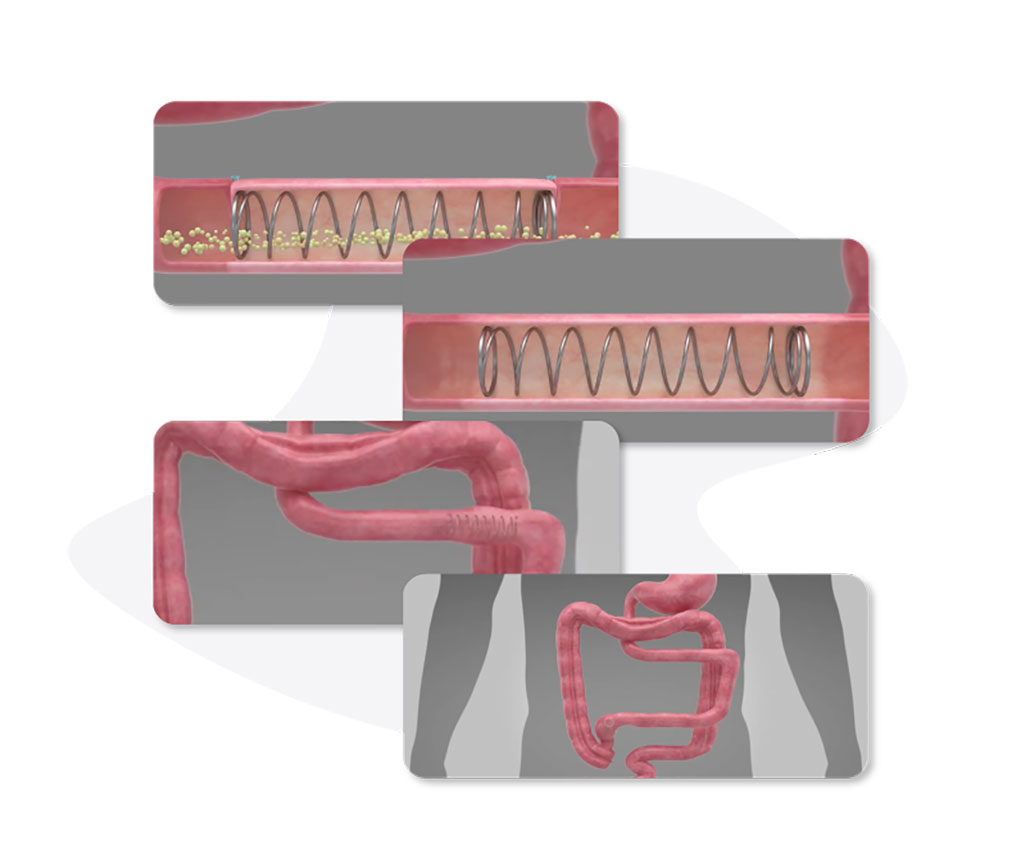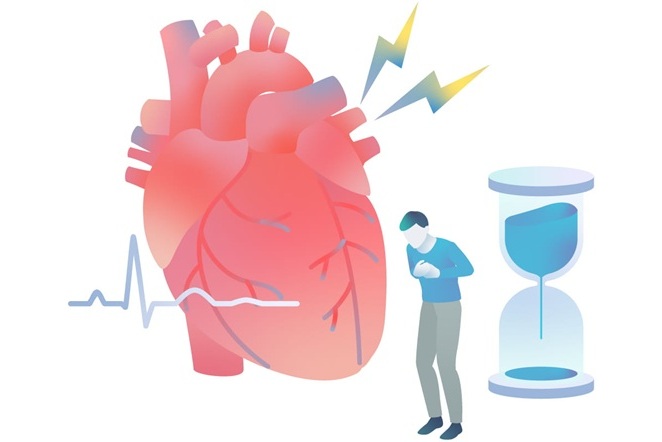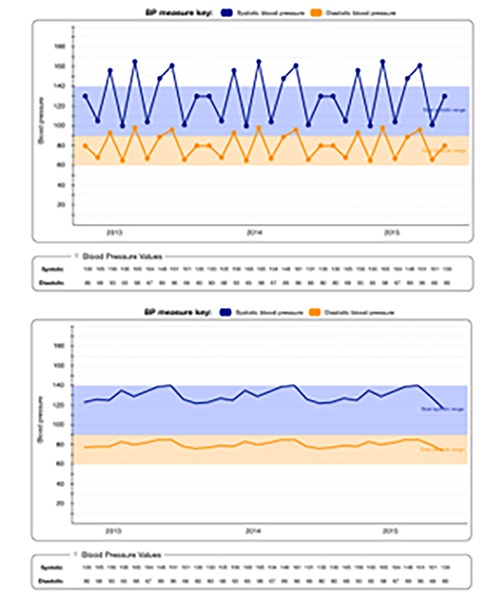Mechanotransduction Device Treats Small Bowel Syndrome 
|
By HospiMedica International staff writers Posted on 05 Jan 2022 |

Image: The Eclipse XL1 placed inside the shortened small bowel (Photo courtesy of Eclipse Regenesis)
A prototype spring-like device applies controlled force to expand healthy tissue in patients suffering from short bowel syndrome (SBS).
The Eclipse Regenesis (Menlo Park, CA, USA) XL1 is a small, compressed coil that is placed inside the small intestine, secured at both ends with plication sutures. The natural expansion and contraction of the intestine work against the resistance of the device, leading to a mechanical transduction that stretches the bowel. Over a two to three week period, the compressed coil device slowly expands to its relaxed state, stimulating new tissue growth in the treated segment, and ultimately expanding it to two to three times the segment’s original length (about four cm).
Once the process is complete, the chromic sutures dissolve, allowing the XL1 to pass through the body to be excreted. Treatment length varies, depending on the starting point (amount of small intestine), the end point (how much new intestine is needed) needed to reduce total parenteral nutrition dependence. Preclinical studies show successful lengthening of the bowel, no perforations, and no obstructions. The newly formed tissue looks and acts like normal intestinal tissue with regard to metabolic uptake and contractile function.
“The basic concept is similar to distraction osteogenesis, which orthopedic surgeons have used for years, applying distraction force to broken bone that will grow up to a millimeter a day,” said Andre Bessette, CEO and a co-founder of Eclipse Regenesis. “Patients with SBS have lost more than 50% of their small intestine, so they’ll need more than one device applied or more than one procedure. We are getting close to performing the first-in-human procedure, and we hope to eventually be able to perform this procedure completely endoscopically.”
SBS is a devastating condition where patients struggle to absorb life-sustaining nutrients from their diet. It typically results from intestinal resection due to necrotizing enterocolitis (NEC), which takes place when the lining of the intestinal wall becomes infected and dies. It can also result from birth defects, such as Gastroschisis, Volvulus, Hirschsprung’s Disease, Intestinal Atresia, and other congenital defects. Patients struggle to absorb life-sustaining nutrients from their diet, and many become reliant on total parenteral nutrition (TPN) to survive.
Related Links:
Eclipse Regenesis
The Eclipse Regenesis (Menlo Park, CA, USA) XL1 is a small, compressed coil that is placed inside the small intestine, secured at both ends with plication sutures. The natural expansion and contraction of the intestine work against the resistance of the device, leading to a mechanical transduction that stretches the bowel. Over a two to three week period, the compressed coil device slowly expands to its relaxed state, stimulating new tissue growth in the treated segment, and ultimately expanding it to two to three times the segment’s original length (about four cm).
Once the process is complete, the chromic sutures dissolve, allowing the XL1 to pass through the body to be excreted. Treatment length varies, depending on the starting point (amount of small intestine), the end point (how much new intestine is needed) needed to reduce total parenteral nutrition dependence. Preclinical studies show successful lengthening of the bowel, no perforations, and no obstructions. The newly formed tissue looks and acts like normal intestinal tissue with regard to metabolic uptake and contractile function.
“The basic concept is similar to distraction osteogenesis, which orthopedic surgeons have used for years, applying distraction force to broken bone that will grow up to a millimeter a day,” said Andre Bessette, CEO and a co-founder of Eclipse Regenesis. “Patients with SBS have lost more than 50% of their small intestine, so they’ll need more than one device applied or more than one procedure. We are getting close to performing the first-in-human procedure, and we hope to eventually be able to perform this procedure completely endoscopically.”
SBS is a devastating condition where patients struggle to absorb life-sustaining nutrients from their diet. It typically results from intestinal resection due to necrotizing enterocolitis (NEC), which takes place when the lining of the intestinal wall becomes infected and dies. It can also result from birth defects, such as Gastroschisis, Volvulus, Hirschsprung’s Disease, Intestinal Atresia, and other congenital defects. Patients struggle to absorb life-sustaining nutrients from their diet, and many become reliant on total parenteral nutrition (TPN) to survive.
Related Links:
Eclipse Regenesis
Latest Surgical Techniques News
- DNA Origami Improves Imaging of Dense Pancreatic Tissue for Cancer Detection and Treatment
- Pioneering Sutureless Coronary Bypass Technology to Eliminate Open-Chest Procedures
- Intravascular Imaging for Guiding Stent Implantation Ensures Safer Stenting Procedures
- World's First AI Surgical Guidance Platform Allows Surgeons to Measure Success in Real-Time
- AI-Generated Synthetic Scarred Hearts Aid Atrial Fibrillation Treatment
- New Class of Bioadhesives to Connect Human Tissues to Long-Term Medical Implants
- New Transcatheter Valve Found Safe and Effective for Treating Aortic Regurgitation
- Minimally Invasive Valve Repair Reduces Hospitalizations in Severe Tricuspid Regurgitation Patients
- Tiny Robotic Tools Powered by Magnetic Fields to Enable Minimally Invasive Brain Surgery
- Magnetic Tweezers Make Robotic Surgery Safer and More Precise
- AI-Powered Surgical Planning Tool Improves Pre-Op Planning
- Novel Sensing System Restores Missing Sense of Touch in Minimally Invasive Surgery
- Headset-Based AR Navigation System Improves EVD Placement
- Higher Electrode Density Improves Epilepsy Surgery by Pinpointing Where Seizures Begin
- Open-Source Tool Optimizes Placement of Visual Brain Implants
- Easy-To-Apply Gel Could Prevent Formation of Post-Surgical Abdominal Adhesions
Channels
Critical Care
view channel
Breakthrough AI Technology Accurately Assesses Heart Failure Severity
Heart failure (HF) is a complex condition where the heart cannot effectively pump blood to meet the body’s needs due to underlying medical issues. It is marked by recurring episodes and frequent hospitalizations.... Read more
New Approach to Visualizing Blood Pressure Data Can Help Better Manage Hypertension Patients
Sometimes, a patient’s blood pressure may be elevated in a doctor's office but normal at home, a phenomenon known as white coat hypertension. It is estimated that 10% to 20% of high blood pressure diagnoses... Read morePatient Care
view channel
Portable Biosensor Platform to Reduce Hospital-Acquired Infections
Approximately 4 million patients in the European Union acquire healthcare-associated infections (HAIs) or nosocomial infections each year, with around 37,000 deaths directly resulting from these infections,... Read moreFirst-Of-Its-Kind Portable Germicidal Light Technology Disinfects High-Touch Clinical Surfaces in Seconds
Reducing healthcare-acquired infections (HAIs) remains a pressing issue within global healthcare systems. In the United States alone, 1.7 million patients contract HAIs annually, leading to approximately... Read more
Surgical Capacity Optimization Solution Helps Hospitals Boost OR Utilization
An innovative solution has the capability to transform surgical capacity utilization by targeting the root cause of surgical block time inefficiencies. Fujitsu Limited’s (Tokyo, Japan) Surgical Capacity... Read more
Game-Changing Innovation in Surgical Instrument Sterilization Significantly Improves OR Throughput
A groundbreaking innovation enables hospitals to significantly improve instrument processing time and throughput in operating rooms (ORs) and sterile processing departments. Turbett Surgical, Inc.... Read moreHealth IT
view channel
Printable Molecule-Selective Nanoparticles Enable Mass Production of Wearable Biosensors
The future of medicine is likely to focus on the personalization of healthcare—understanding exactly what an individual requires and delivering the appropriate combination of nutrients, metabolites, and... Read more
Smartwatches Could Detect Congestive Heart Failure
Diagnosing congestive heart failure (CHF) typically requires expensive and time-consuming imaging techniques like echocardiography, also known as cardiac ultrasound. Previously, detecting CHF by analyzing... Read moreBusiness
view channel
Expanded Collaboration to Transform OR Technology Through AI and Automation
The expansion of an existing collaboration between three leading companies aims to develop artificial intelligence (AI)-driven solutions for smart operating rooms with sophisticated monitoring and automation.... Read more

















